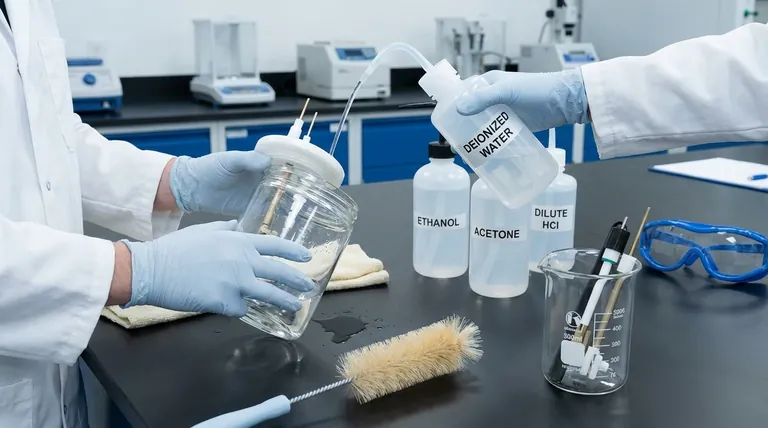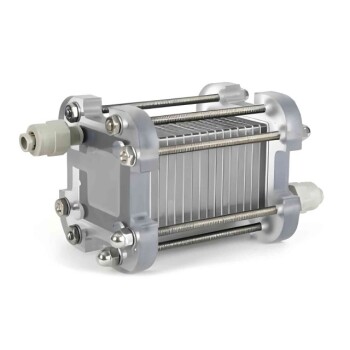A successful cleaning routine for an electrolytic cell is a multi-step process that begins immediately after use. It involves an initial rinse with deionized water or ethanol, followed by more targeted chemical cleaning with dilute acids or bases for stubborn residues, always concluding with a thorough final rinse to remove any cleaning agents.
The core principle of electrolytic cell maintenance is not just about cleaning, but about preserving the integrity of the cell's surfaces. An effective routine prevents cross-contamination and damage, ensuring the accuracy and repeatability of future experiments.

The Foundation: Immediate Post-Experiment Cleaning
The most critical step in maintaining your electrolytic cell is acting quickly. Residues from an experiment are easiest to remove before they have a chance to dry and adhere to the surfaces.
Why Immediate Action is Crucial
Letting a cell sit after an experiment allows residues to harden and potentially react with the electrode surfaces. This buildup can interfere with subsequent reactions, leading to inaccurate results and making cleaning significantly more difficult.
The Standard First-Step Rinse
Immediately after your experiment concludes, rinse the reaction vessel and electrodes thoroughly. Use deionized water or ethanol for this initial wash. This simple step will remove the majority of electrolytes and reaction products.
A Tiered Approach to Stubborn Deposits
Sometimes, a simple rinse is not enough. When you encounter stubborn deposits or visible oxides, a more targeted chemical approach is necessary.
When to Use Chemical Cleaners
Chemical cleaning is reserved for residues that cannot be removed by simple rinsing. This often includes metal oxides, such as rust, or other persistent inorganic deposits.
Matching the Cleaner to the Contaminant
The choice of chemical agent depends entirely on the nature of the deposit. For example, a dilute hydrochloric acid solution is effective for removing iron oxides. For other types of buildup, a dilute base may be more appropriate.
The Deep-Cleaning Protocol
For a cell that has been used previously or has significant unknown buildup, a more intensive sequence is recommended. First, scrub the inner walls with acetone, then rinse with ethanol, and finally rinse thoroughly with ultrapure water.
Critical Safety and Handling Procedures
Improper cleaning can be more damaging than no cleaning at all. Following strict safety and handling protocols is essential to protect both the user and the equipment.
The "Do Not Mix" Rule: Acids and Bases
Never mix acid and alkaline cleaning agents. Combining substances like nitric acid (HNO₃) and sodium hydroxide (NaOH) can trigger a dangerous and violent exothermic reaction. Clean with one, rinse completely, and then use the other if necessary.
Choosing the Correct Tools
Always use a soft cloth or non-abrasive brush for cleaning. Metal brushes are forbidden, as they will permanently scratch the glass body and electrode surfaces, creating sites for future corrosion and contamination.
The Final, Essential Rinse
After any chemical cleaning, you must rinse the cell and its components with a large amount of deionized water. This step is non-negotiable, as it ensures that no residue from the cleaning agent remains to contaminate your next experiment.
Making the Right Choice for Your Goal
Your cleaning strategy should adapt to the specific situation.
- If your primary focus is routine post-experiment maintenance: Immediately rinse the cell thoroughly with deionized water or ethanol to prevent any residue buildup.
- If your primary focus is removing a specific, stubborn deposit: Identify the contaminant and use a targeted chemical cleaner, such as a dilute acid for metal oxides.
- If your primary focus is preparing a cell with an unknown history: Perform a deep clean using the acetone, ethanol, and ultrapure water sequence to ensure a pristine surface.
Proper cell maintenance is the bedrock of reliable electrochemical work, ensuring your results are both accurate and repeatable.
Summary Table:
| Cleaning Step | Purpose | Recommended Agents |
|---|---|---|
| Immediate Rinse | Remove bulk residues post-experiment | Deionized water, Ethanol |
| Chemical Cleaning | Target stubborn deposits (e.g., metal oxides) | Dilute acids (e.g., HCl), Dilute bases |
| Deep Cleaning | Restore a cell with unknown history/ heavy buildup | Acetone, Ethanol, Ultrapure water |
| Final Rinse | Eliminate all cleaning agent residues | Deionized water |
Achieve peak performance and longevity for your lab equipment. Proper maintenance is key to reliable data. KINTEK specializes in high-quality lab equipment and consumables, including electrolytic cells and the pure solvents needed for their care. Let our experts help you optimize your lab's workflows and ensure your experiments are consistently accurate. Contact our team today to discuss your specific laboratory needs!
Visual Guide

Related Products
- Electrolytic Electrochemical Cell with Five-Port
- Double Layer Five-Port Water Bath Electrolytic Electrochemical Cell
- H Type Electrolytic Cell Triple Electrochemical Cell
- Quartz Electrolytic Electrochemical Cell for Electrochemical Experiments
- Double-Layer Water Bath Electrolytic Electrochemical Cell
People Also Ask
- How should the five-port water bath electrolytic cell be operated during an experiment? Master Precise Control for Reliable Results
- What are the standard components of the five-port water bath electrolytic cell? Master the Precision Instrument for Electrochemical Analysis
- How should the five-port water bath electrolytic cell be cleaned for maintenance? A Step-by-Step Guide to Reliable Results
- What is the proper way to handle a five-port water bath electrolytic cell? Ensure Accurate and Safe Electrochemical Experiments
- What are the proper storage procedures for the multifunctional electrolytic cell? Protect Your Investment and Ensure Data Accuracy



















